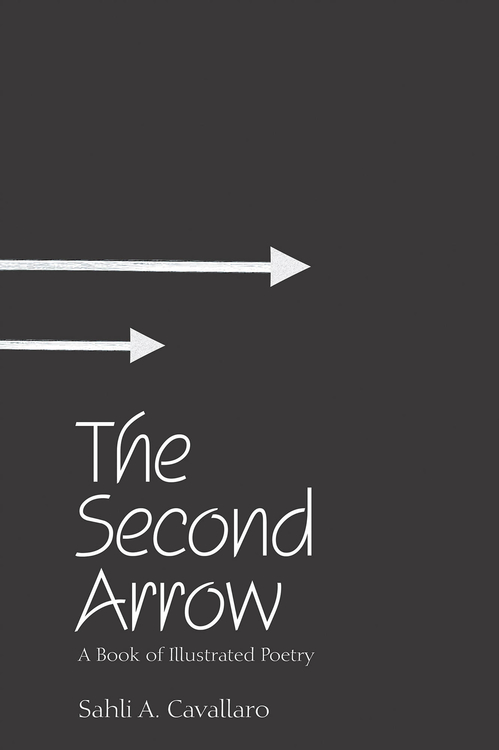
With a pervading air of mystery and curiosity, poet Sahli A. Cavallaro probes the puzzles of life, love, connection and meaning in The Second Arrow: A Book of Illustrated Poetry, an exploratory and experimental collection.
With poems that range from the whimsical and musing to the heavy and emotionally vulnerable, this gathering of work is linguistically unique, and buttressed by detailed illustrations that break up the experience for readers. One could argue that this is a dark collection, but it is more varied than that, with plenty of existential weight mixed with splashes of playfulness and intrigue.
In “Comfort Just Got a Makeover,” written in honor of civilian casualties in Afghanistan, there is quiet power and resilience, as well as a collage-like approach to storytelling, using simple and seemingly unrelated imagery to shine a light on intense subjects. “Tiger Hunting in India” touches on ecosystem sustainability and the greedy lust of mankind for dominance, while “How to Snap a Whip” explores the complexity of violence and eroticism, and what it may say about the flaws in our broader society.
Other poems are more narrative, such as “Jeannett’s Impediment,” plunging readers into the mind and struggles of another time, place, person, and skin color. This broad range of subject matter is impressively tackled with grace and sensitivity, specifically when technical aspects of the poems aren’t the focus. Using a combination of unexpected formatting, oddly juxtaposed subject matter, powerful imagery, and meticulously chosen language, these more-abstract poems are paradoxical, but also intriguing, such as “The Normal Door w/o Trial and Error” and “How to Play Dead.” Many of these short, impactful pieces require a second read to fully savor the atmospheric verse.
There are also a number of pieces that feel flat and less polished, particularly when it comes to enjambment choices. At times, these pieces could be stretched out into prose without compromising their meaning in any way. Poems like “I am Your Reflection” are potent in their potential, but the execution feels repetitive, as though based on a foundation that hasn’t been fully examined. There is something to be said for unveiling one’s mindset and ideas through the act of creating, but there is a tangential, unfocused tone to some of this work. In “Riding on Empty and Sunk in the Grass,” for example, there is inconsistency in the rhyme scheme and rhythm of the poem, as well as repetitive word use and imagery that makes the piece seem unfinished.
Similarly, the illustrations create some variety in the reading experience, but they are not of equal quality; the image for “Eso” is detailed and striking, while the image preceding “The Water,” feels rudimentary and childlike. Linked images in a poetry collection don’t necessarily need to be on par with the verse, but the occasionally sloppy nature of the poetry is reflected in the accompanying art.
While there are certainly areas for improvement, The Second Arrow remains a memorable and original collection, and reveals the poet’s endless curiosity as a poetic witness to our strange and dynamic world.
Book Links
STAR RATING
Design
Content
Editing
Get an Editorial Review | Get Amazon Sales & Reviews | Get Edited | Get Beta Readers | Enter the SPR Book Awards | Other Marketing Services






















Leave A Comment